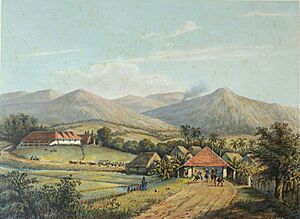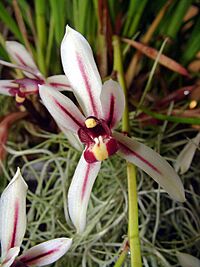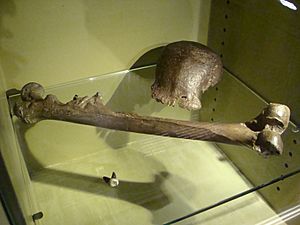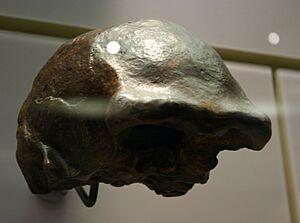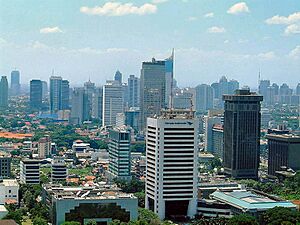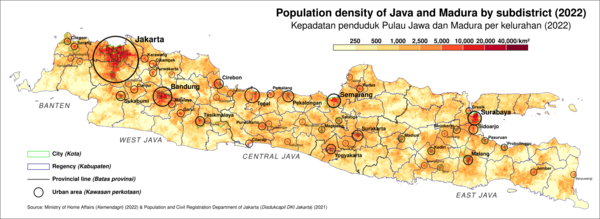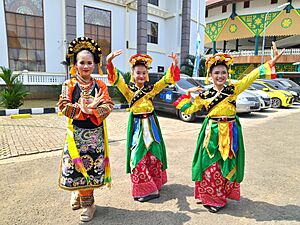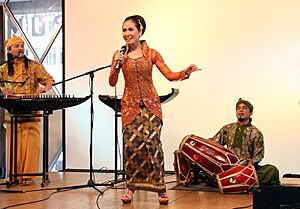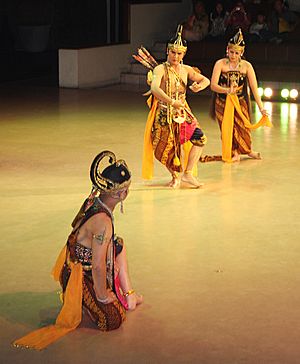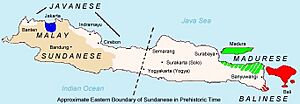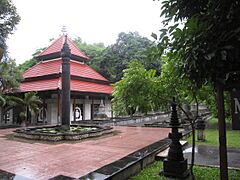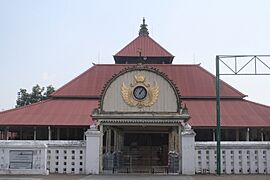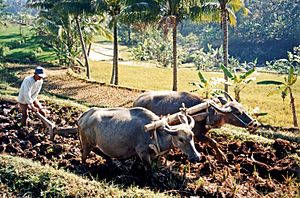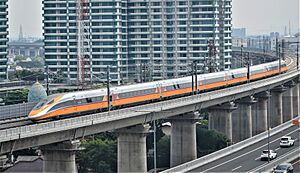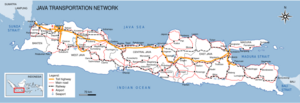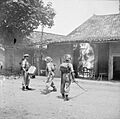Java facts for kids
|
Native name:
|
|
|---|---|
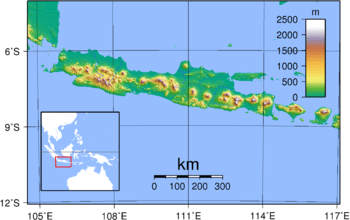
Topography of Java
|
|
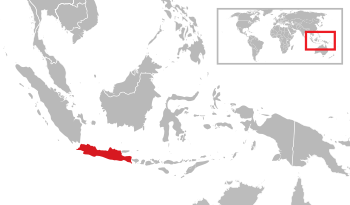 |
|
| Geography | |
| Location | Southeast Asia |
| Coordinates | 7°29′30″S 110°00′16″E / 7.49167°S 110.00444°E |
| Archipelago | Indonesian Archipelago
Greater Sunda Islands |
| Area | 132,011.65 km2 (50,969.98 sq mi) |
| Area rank | 13th |
| Highest elevation | 3,678 m (12,067 ft) |
| Highest point | Semeru |
| Administration | |
| Provinces | Banten, Special Region of Jakarta, West Java, Central Java, Special Region of Yogyakarta, East Java |
| Largest settlement | West Java (pop. 49,956,890) |
| Demographics | |
| Population | 156,391,145 (mid 2023) |
| Pop. density | 1,219 /km2 (3,157 /sq mi) |
| Ethnic groups | Javanese (inc. Tenggerese, Osing, Banyumasan), Sundanese (inc. Baduy, Bantenese, Cirebonese), Madurese (inc. Bawean, Pendalungan), Betawi, etc. |
| Additional information | |
| Time zone |
|
Java is a large island in Indonesia, located in Southeast Asia. It's part of the Greater Sunda Islands. The Indian Ocean is to its south, and the Java Sea is to its north.
Java is the most populated island in the world. About 156.4 million people live there. This means about 56% of all Indonesians call Java home. Jakarta, Indonesia's capital city, is on Java's northwest coast.
Many important events in Indonesian history happened on Java. It was once the center of powerful Hindu-Buddhist kingdoms. Later, Islamic sultanates ruled the island. It also became the main part of the colonial Dutch East Indies. Java was key to Indonesia's fight for independence in the 1930s and 1940s.
Today, Java is very important for Indonesia's politics, economy, and culture. Four of Indonesia's eight UNESCO World Heritage Sites are found here. These include Ujung Kulon National Park, Borobudur Temple, Prambanan Temple, and Sangiran Early Man Site.
Java was created by volcanoes. This happened because the Australian Plate slid under the Sunda Plate. It is the 13th largest island globally. It is also the fifth largest in Indonesia. Its land area is about 132,011.65 square kilometers (50,970 square miles). This includes Madura Island. A chain of volcanoes runs across the island from east to west.
People on Java speak four main languages. These are Javanese, Sundanese, Madurese, and Betawi. Javanese and Sundanese are the most common. The Javanese live in the central and eastern parts. The Sundanese live in the western parts.
Most people on Java are Muslim. However, the island has many different religions, ethnic groups, and cultures. Most residents speak Indonesian. They use it as their first or second language.
Java is divided into four provinces. These are Banten, West Java, Central Java, and East Java. It also has two special regions: Jakarta and Yogyakarta.
Contents
What's in a Name? The Origin of "Java"
The name "Java" has a mysterious past. No one is completely sure where it came from. One idea is that it comes from the jáwa-wut plant. This plant was very common on the island long ago.
Another idea links the name to the Sanskrit word yava, which means barley. Barley was a famous plant on the island. An ancient Indian epic, the Ramayana, mentions "Yavadvipa." This means "barley island."
The Greek geographer Ptolemy wrote about a large island called Iabadiu or Jabadiu around 150 CE. He said it meant "barley island" and had lots of gold. This name likely refers to Java.
Ancient Chinese records from the 5th century CE called Java "She-pó." Later, during the Yuan dynasty (1271–1368), they started calling it "Zhao-Wa."
Java's Geography and Landscapes
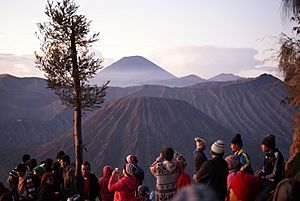
Java is located between Sumatra to its west and Bali to its east. Borneo is to the north, and Christmas Island is to the south. It is the 13th largest island in the world.
The island is surrounded by water. The Java Sea is to the north. The Sunda Strait is to the west. The Indian Ocean is to the south. The Bali Strait and Madura Strait are to the east.
Java was mostly formed by volcanoes. It has 38 mountains that are active volcanoes. In total, Java has over 150 mountains. The highest volcano is Mount Semeru, which is 3,676 meters (12,060 feet) tall. The most active volcano is Mount Merapi, at 2,930 meters (9,613 feet).
Java's mountains create many isolated areas. These areas are perfect for growing wet-rice. Java's rice fields are some of the richest in the world. Coffee was first grown in Indonesia on Java in 1699.
Java is about 1,000 kilometers (620 miles) long. It can be up to 210 kilometers (130 miles) wide. The longest river on the island is the Solo River. It is 600 kilometers (370 miles) long. It flows north and east to the Java Sea near Surabaya. Other big rivers include Brantas, Citarum, Cimanuk, and Serayu.
The average temperature on Java is between 22°C (72°F) and 29°C (84°F). The air is usually humid, around 75%. The northern coastal areas are hotter. They can reach 34°C (93°F) during the day in the dry season. The south coast is cooler, and highland areas are even colder.
The wet season starts in November and ends in April. Rain usually falls in the afternoons. The wettest months are January and February. Western Java gets more rain than Eastern Java. Mountainous areas receive the most rainfall.
Java's Amazing Nature and Wildlife
Java is an island with a huge variety of plants and animals. Its natural environment is tropical rainforest. This includes mangrove forests on the north coast. There are also rocky cliffs on the south coast. Inside the island, you'll find low-lying tropical forests and high-altitude rainforests on volcano slopes.
The environment changes from west to east. The west has wet, humid, dense rainforests. The east becomes a drier savanna environment. This matches the rainfall patterns across the island.
Java used to have many unique animals and plants. Some of these endemic species were the Javan rhinoceros, Javan banteng, Javan warty pig, and Javan hawk-eagle. Other animals included the Javan peafowl, Javan silvery gibbon, Javan lutung, Java mouse-deer, Javan rusa, and Javan leopard. Java is a great place for birdwatchers, with over 450 bird species. About 37 of these are found only on Java.
Over time, people have cleared rainforests to create rice paddies. These rice terraces have been around for over a thousand years. They helped ancient farming kingdoms grow. However, the growing human population has put a lot of pressure on Java's wildlife. Rainforests have shrunk to small areas on mountain slopes or isolated peninsulas.
Some of Java's unique species are now critically endangered. Sadly, some animals like the Javan tiger and Javan elephant are now extinct. Today, Java has several national parks. These parks protect the remaining wildlife. Examples include Ujung Kulon National Park, Mount Halimun-Salak, and Bromo Tengger Semeru.
Java's Rich History
Early Human Life: Homo Erectus
Fossils of an early human species called Homo erectus were found on Java. These fossils are known as "Java Man." They are about 1.3 million years old. They were found along the Bengawan Solo River.
Homo erectus arrived in Asia about 1.8 million years ago. This was the first time early humans left Africa. The Java Homo erectus lived in a forest environment. It was like a savanna but often flooded. Plants found at their sites included grass, ferns, and fig trees.
A later group, H. e. soloensis, was the last Homo erectus population on Java. They lived there between 117,000 and 108,000 years ago. They might have been the last Homo erectus in East Asia.
After Modern Humans Arrived
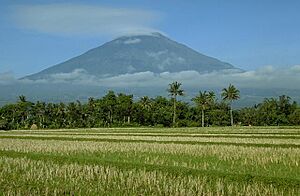
Java's very fertile land and good rainfall allowed people to grow a lot of rice. This needed villages to work together. From these alliances, small kingdoms began to form.
The chain of volcanoes and highlands across Java kept different regions separate. Rivers were the main way to travel and communicate. However, most rivers on Java are short. Only the Brantas and Solo rivers were long enough for long-distance travel. These river valleys became home to major kingdoms.
Ancient texts mention Java having organized governments very early on. The Greek geographer Ptolemy called the island Yabadiou or Sabadiou. Chinese records also talk about Javanese kingdoms existing long ago.
Hindu-Buddhist Kingdoms
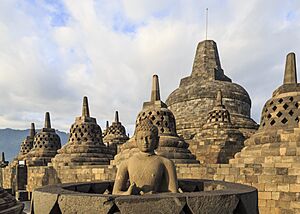
The Taruma and Sunda kingdoms appeared in western Java between the 4th and 7th centuries. The first major kingdom was the Mataram Kingdom in central Java. It started in the early 8th century. Mataram focused on the Hindu god Shiva. They built some of Java's first Hindu temples on the Dieng Plateau.
Around the 8th century, the Sailendra dynasty rose. They supported Mahayana Buddhism. This kingdom built famous monuments like the 9th-century Borobudur and Prambanan temples.
Around the 10th century, power moved from central to eastern Java. Kingdoms like Kediri, Singhasari, and Majapahit grew there. They relied on rice farming but also traded with other islands, China, and India.
The Majapahit kingdom was very powerful. By the late 1300s, it claimed control over the entire Indonesian archipelago. Its prime minister, Gajah Mada, led many conquests. Majapahit was Java's first trading empire. It controlled ports and shipping routes. After its decline, Islam began to spread in Indonesia.
The Rise of Islamic Sultanates
Islam became the main religion in Java by the late 16th century. During this time, Islamic kingdoms like Demak, Cirebon, and Banten became strong. The Mataram Sultanate became the most powerful in central and eastern Java. Only Mataram and Banten were left to face the Dutch in the 17th century.
Colonial Rule in Java

Europeans first arrived in Java in 1522. The Portuguese made a treaty with the Sunda kingdom. Later, the Dutch arrived in 1596. By the late 1700s, the Dutch had taken control over Java's kingdoms. They used the Dutch East India Company.
Java was very important for growing rice during the early colonial period. It also became a major producer of commercial crops. The Dutch introduced plants like sugarcane, rubber, coffee, and tea.
During the Napoleonic wars in Europe, France took over the Netherlands. This meant Java became a French colony for a short time. From 1808, the Great Post Road was built across Java. This road helped move military supplies. In 1811, the British captured Java. Sir Stamford Raffles became its governor. But in 1816, Java was given back to the Dutch.
Java's population grew very fast in the 19th century. This was due to peace under Dutch rule. Also, more land was used for rice. New food plants like cassava and maize were introduced. Some people believe the Dutch's "Cultivation System" also led to more children being born. Families hoped more children would help pay taxes and buy goods.
New transport like trucks and railways helped prevent famines. Telegraph systems also improved communication. There were no major famines in Java from the 1840s until the Japanese occupation in the 1940s.
Independence for Indonesia
Indonesian nationalism started in Java in the early 1900s. The fight for independence after World War II was also centered on Java. In 1949, Indonesia officially became an independent country.
How Java is Governed
Java is divided into four provinces and two special regions:
- Banten, with its capital at Serang
- Special Region of Jakarta (the capital city of Indonesia)
- West Java, with its capital at Bandung
- Central Java, with its capital at Semarang
- Special Region of Yogyakarta, with its capital at Yogyakarta
- East Java, with its capital at Surabaya. This province also includes Madura Island.
People and Culture of Java
Population and Growth
| Historical population | ||
|---|---|---|
| Year | Pop. | ±% |
| 1961 | 63,059,575 | — |
| 1971 | 76,086,320 | +20.7% |
| 1980 | 91,269,528 | +20.0% |
| 1990 | 107,581,306 | +17.9% |
| 2000 | 121,352,608 | +12.8% |
| 2010 | 136,610,590 | +12.6% |
| 2015 | 145,013,583 | +6.2% |
| 2020 | 151,591,262 | +4.5% |
| 2023 | 156,391,145 | +3.2% |
| Refers to the administrative region (including Madura). | ||
Java has always had a ruling class and people who worked in farming and fishing. Over time, different cultures came to the island. This included people from South Asia, Arabia, and Persia. More recently, Chinese immigrants have also become part of Java's economy.
Even though Java is becoming more modern, about 75% of the island has electricity. Villages and rice paddies are still common sights. Many people from Central Java move to bigger cities for better jobs.
Java is the most populated major island in the world. It is home to 56% of Indonesia's people. In mid-2023, about 156.4 million people lived there. This includes Madura's 4.06 million people.
Java is also one of the most densely populated places. There are nearly 1,185 people per square kilometer in 2023. This is similar to Bangladesh. Because of many volcanoes, people share the flatter land. So, many coasts are heavily populated. Cities often surround the valleys near volcanic peaks.
About 45% of Indonesia's population is ethnically Javanese. Sundanese people also make up a large part of Java's population. The western part of Java has an even higher population density. It includes the big cities of Greater Jakarta, Greater Bandung, and Greater Cirebon.
From the 1970s to 1998, the Indonesian government moved people from Java to less populated islands. This program had mixed results. It sometimes caused problems between locals and new settlers. But it did help reduce Java's share of the nation's population.
Jakarta and its surrounding areas attract people from all over Indonesia. East Java also has many ethnic Balinese people. There are also many Madurans who moved there because of poverty on their home island.
Ethnic Groups and Culture
Java has a large population but is quite similar in its ethnic makeup. Only two main ethnic groups are native to the island. These are the Javanese and Sundanese. A third group, the Madurese, live on Madura Island. Many have moved to East Java since the 18th century.
The Javanese make up about two-thirds of the island's population. The Sundanese are about 38%, and the Madurese are about 10%. The fourth group is the Betawi people. They speak a dialect of Malay. They are descendants of people who lived around Batavia since the 17th century. Betawis are a mix of many Indonesian and foreign ethnic groups. They have their own unique culture and language.
There are four main cultural areas on Java:
- The central part of Java, including Yogyakarta, is the heartland of the Javanese people.
- The north coast, or pasisir region.
- The Sunda lands in western Java, with Parahyangan as its heartland.
- The eastern salient of Java, also known as Blambangan.
Madura is a fifth area. It has strong cultural ties with eastern Java. The kejawen Javanese culture is the most important on the island. Java's remaining royal families are based here. This region is also where many of Indonesia's army, business, and political leaders come from. Its language, arts, and manners are seen as the most refined.
In the southwestern part of Central Java, called the Banyumasan region, Javanese and Sundanese cultures mixed. This created the Banyumasan culture. In the Javanese court cities of Yogyakarta and Surakarta, kings trace their family lines back to ancient Islamic kingdoms. These cities keep classical Javanese culture alive. Famous Javanese arts include gamelan music and wayang puppet shows.
Java has been home to many important kingdoms. Because of this, many literary works have been written by Javanese authors. These include Ken Arok and Ken Dedes, a story about an orphan who became king. There are also Javanese versions of the Indian epics Ramayana and Mahabharata.
Languages Spoken on Java
The three main languages spoken on Java are Javanese, Sundanese, and Madurese. Other languages include Betawi (a Malay dialect from Jakarta), Osing, Banyumasan, and Tenggerese. The vast majority of people also speak Indonesian, often as a second language.
Religions and Beliefs
| Religions | Total |
|---|---|
| Islam | 151,001,350 |
| Protestant | 3,551,176 |
| Roman Catholic | 1,677,824 |
| Buddhism | 755,560 |
| Hinduism | 168,055 |
| Aliran Kepercayaan | 21,855 |
| Confucianism | 20,303 |
| Overall | 157,196,123 |
Religion in Java (2023) Islam (96.06%) Protestant (2.26%) Roman Catholic (1.07%) Buddhism (0.48%) Hinduism (0.11%) Aliran Kepercayaan (0.01%)
Influences from India first brought Shaivism (a form of Hinduism) and Buddhism to Java. These blended with local traditions. Spiritual teachers called resi taught mystical practices. At the royal courts, Hindu priests and scholars helped rulers connect their power to Hindu beliefs. Small Hindu communities are found across Java. A larger Hindu population lives along the eastern coast, near Bali, especially around Banyuwangi.
Islam became the main religion in Java by the end of the 16th century. Most Muslims in Java are Sunnis. There are very few Shia and Ahmadis. Muslim scholars, called Kyai, became new religious leaders as Hindu influences faded. In Javanese Islamic schools (pesantren), the Kyai continued the tradition of the resi.
-
A Hindu shrine dedicated to King Siliwangi in Pura Parahyangan Agung Jagatkarta, Bogor.
-
Masjid Gedhe Kauman in Yogyakarta, built with a traditional Javanese multi-tiered roof.
Java's older traditions have given Islam a mystical side. This led to a flexible system of religious leaders. These kyais knew a lot about both old Javanese and Islamic beliefs. They acted as a link between villagers and the spiritual world. However, this flexible system also led to different groups.
There are often differences between strict kyais who teach Islamic law and those who teach mysticism. There are also those who want to mix Islam with modern science. This has created a divide between santri and abangan. Santri believe they follow Islam more strictly. Abangan have mixed older Javanese beliefs, like animism and Hindu-Indian ideas, with a basic acceptance of Islam.
There are also Christian communities on Java. They are mostly in bigger cities. Many are Chinese Indonesian or Javanese. Some rural areas in south-central Java have strong Roman Catholic communities. Buddhist communities also exist in major cities, mainly among Chinese Indonesians. The Indonesian constitution recognizes six official religions.
Many different religious groups exist in Java. In 1956, 63 religious groups were reported in Java, not counting the official religions. These include Kejawen, Sumarah, and Subud. It's hard to know how many people belong to these groups. Many followers also identify with one of the official religions. Sunda Wiwitan is a traditional Sundanese religion. Its followers still live in some villages.
Java's Economy and Trade
In ancient times, Java's economy depended heavily on rice farming. Old kingdoms like Kingdoms of Sunda, Mataram, and Majapahit relied on rice harvests and taxes. Java was known for having extra rice and exporting it. Rice farming also helped the island's population grow.
Trade with other parts of Asia, like ancient India and China, started as early as the 4th century. Chinese pottery from that time has been found on the island. Java also took part in the global trade of Maluku spices. This happened from the Majapahit era until the Dutch East India Company (VOC) arrived.
The VOC set up in Batavia in the 17th century. Later, the Dutch East Indies took over in the 19th century. During colonial times, the Dutch started growing commercial crops in Java. These included sugarcane, rubber, coffee, tea, and quinine. In the 19th and early 20th centuries, Javanese coffee became famous worldwide. That's why "Java" is still a nickname for coffee today.
Java has been Indonesia's most developed island since the Dutch colonial era. It remains so today. Old road networks were improved when the Java Great Post Road was built in the early 1800s. This road became the main route for Java's transportation. It also formed the base for the Java North Coast Road.
The need to move crops like coffee from farms to ports led to the building of railways. Today, industries, businesses, trade, and services are strong in Java's major cities. These include Jakarta, Surabaya, Semarang, and Bandung. Some traditional cities like Yogyakarta, Surakarta, and Cirebon keep their royal history alive. They are now centers for art, culture, and tourism.
Industrial areas are also growing along Java's northern coast. These are in towns like Cilegon, Tangerang, Bekasi, Karawang, Gresik, and Sidoarjo. Highway networks have been built and expanded. They connect major cities and their surrounding areas. Java also has 16 national highways.
According to data from 2021, Java alone contributes about 60% of Indonesia's total economy. This is equal to about US$686 billion.
Images for kids
See also
 In Spanish: Java (isla) para niños
In Spanish: Java (isla) para niños


